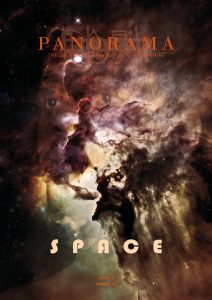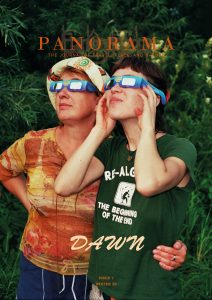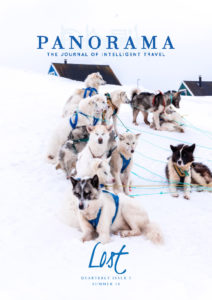When Flóki Vilgerdarson set out from Denmark with his family in search of a rumoured land beyond the Faeroe Islands, he brought three ravens. It was the 9th century. Vikings navigated by the stars and by their knowledge of birds, noting the migratory routes and behaviour of different species. Lost in a featureless expanse of ocean, Flóki released the first bird. It went back the way they’d come, toward the Faeroes. The second raven circled around and returned to the ship. But the third flew in a new direction, toward the northwest. Flóki followed it, eventually finding, and naming, Iceland. In the Icelandic Book of Settlement, he’s known as Hrafna-Flóki, meaning “Raven Flóki.”
*****
At Seljalandsfoss, the lush green cliffs behind the waterfall are dotted with white birds. Others wheel in the blue sky above. There are eight of us on this family trip to Iceland: me and my son and daughter; my mother and step-father; my sister and her two boys. In two camper vans, we’re here to drive the Ring Road all the way around the country. We’re dazed now after our overnight flight from New York, still getting our bearings. Even so, my mother has her binoculars handy. ‘Fulmars,’ she says, with a nod toward the birds, and passes them to my daughter.
In our family, birding and travel have always been linked. My mother’s father was an amateur ornithologist from England who sailed around the world in the 1930s, eventually settling on Long Island, NY. For years he worked on expedition cruise ships, traveling from Iceland to Antarctica and many places in between, giving lectures and leading birding tours on shore. The oldest of his seven grandchildren, I often accompanied him, skipping weeks of school to go to Australia one year, the Red Sea the next.
The first time I came to Iceland was with him. I remember cliffs of nesting puffins, and hiking with him up a rocky volcanic slope in the Westman Islands. Plumes of steam wreathed upward from the ropey, fissured ground, and it seemed to me that the land was still in the process of forming, unfinished and plastic.
*****
By the time my daughter was born, my grandfather’s world had been reduced to a brown recliner in his house on the south shore of Long Island, not far from where I then lived. I brought her to visit him nearly every day. They loved each other. He was in his nineties and almost deaf; my daughter was just learning to talk. She’d climb onto his lap with a dog-eared copy of Peterson’s Field Guide to Birds, and flip through the brightly colored pages. Pointing to a bird with her little dimpled finger, she’d tilt her head in concentration, listening as he told her the name of the species.
Seventeen now, she trains my mother’s binoculars on a passing fulmar. She’s looking for the bumpy protuberance on its beak, used for expelling salt, that allows pelagic birds to drink seawater. She’s visited the Arctic with her grandparents before, and knows a tubenose when she sees one.
Her brother and cousins are more interested in the waterfall. It crashes down in a massive curtain, sending up bouts of spray. We hike to it along a slippery path. My son, age 15, and his 14 and 10 year-old cousins run ahead, laughing and calling. Later, back by the vehicles, I find all four kids playing with the camera on my sister’s phone. They’ve set it on panoramic mode and are flailing and contorting in front of the view-finder. Next they huddle around to inspect the results, shrieking with delight at their unrecognizable selves, impossibly elongated, with smeared or bifurcated faces, some missing limbs, others many-armed as Hindu deities. All school year my daughter has struggled with anxiety and panic attacks. The sight of her goofing off with the boys is an enormous relief.
*****
Like a flock of birds ourselves, we alight noisily in place after place. From Seljalandsfoss we head southeast for Dyrhólaey. With the help of an app on my sister’s phone, we try to pronounce the Icelandic names. Dyrhólaey sounds something like ‘deer-lay.’ It’s a popular birding site at the southernmost point in Iceland, the tip of a peninsula where puffins and arctic terns breed. Vehicles crowd the winding roadside as we approach, but we find space for the two we’ve rented: a six-person camper van with beds for me, my sister, and the kids, which we’ve dubbed the Behemoth, and the smaller Volkswagen camper where my mother and step-father sleep, called the Honeymoon Suite.
(“Maybe for someone in their thirties,” my step-father mutters.)
Arctic terns are nesting in the grass along both sides of the road, dive bombing passersby. To protect our heads from attack, we raise one arm and hold it upright; terns won’t fly lower than the highest point on one’s body. Arms raised, we navigate beneath them to a long black beach stretched below a rocky volcanic point. On the eastern side, puffins nest along the cliffs, protected from bird-watching tourists like us by a long yellow cordon. The puffins are easy to spot, stubby-bodied with colorful beaks. I point out one with its beak full of sand eels to my son and he studies it through the binoculars. Unlike his sister, he claims he can’t tell one kind of bird from another. At home he pointedly refers to all of them as ‘pigeons.’ But here are species he’s never seen before, and the family ethos is hard to resist.
*****
Iceland’s major thoroughfare runs one lane in each direction. On most of the Ring Road there is no shoulder, and in places the asphalt turns to rutted dirt. Feeling less like a highway and more like a thin ribbon of tarmac, it winds through the wild surrounding landscape, allowing us passage through the countryside without in any way dominating it. There are no billboards out here. Even road signs are rare. Often these are merely the names of family farms, as though, in the loneliness of the country beyond Reykjavík, any human habitation merits official acknowledgement. The houses are white with red or green roofs, flanked by barns and sheep pens. In the lush fields, huge round bales of plastic-wrapped hay lie like monstrous marshmallows, some white, others pink or black.
There are horses and sheep in every corner of the country, even the lips of cliffs overlooking the sea. Barely domesticated, they seem part of the natural order, moving unfettered and on their own terms. The horses run together in wild herds of up to forty, many with wobbly-legged foals birthed this spring. The sheep we see are mostly ewes, each with a pair of lambs. When three of them trot casually out in front of the Behemoth, my stepfather has to brake quickly to avoid hitting them. Books thud to the camper floor. Unperturbed, the sheep amble to the other side. Traffic is the anomaly here. We share the road with livestock and the occasional bicyclist, laboring up a hillside against the wind in a feat of mad endurance.
Lost within the landscape, immersed in fields and sky, we see birds everywhere. They fly overhead, float on the streams and ponds we pass, land on top of the fence posts that stretch along the road. It’s late June, and all over the country eggs are hatching. On the rolling hills, greylag geese are trailed across the grass by new goslings. On a lake we see tufted ducks followed by bobbing ducklings only a day or two old, then a male horned grebe, sitting on a nest. Smaller ponds glint in the sunlight. As we pass I see phalarope swimming with the spinning motion they make as they forage for food, stirring the water with their feet. They look like whirligigs, or small aquatic tops. We see ponds with a single phalarope, others with as many as eight or ten, all whirling across the gleaming surface.
There are redshanks, a shorebird that is a bit larger than a sandpiper, bobbing their heads as they probe their long bills into the soil for worms and insects. Their plumage is nondescript brown, camouflaging them until they fly. Then you see the stripe of white and black above the tail, and their bright red-orange legs.
There are bright red feet on the guillemots, also. These we find nesting farther up the coast on the way to Lón, snug in the peaty cliffs above another black volcanic beach. Sleek black with white wings, the guillemots look like the arctic landscape – dark mountains topped with tongues of ice – rendered in the body of a bird.
*****
Driving southeast on an overcast day, leaving Vik behind, we head toward Hofn. Before us on the long highway looms a low cloud that I realize finally is not a cloud but a glacier. Vatnajökull. Here with my grandfather, years ago, I rode briefly across a section of it on a snowmobile. Now the air carries the suggestion of ice, cold and faintly metallic. The green fields have given way to an outwash plain of boulders and skree, deltas formed by glacial runoff. These stretches of outwash, or sandur, are the largest in the world, a vast plain of silt and rock stretching between the snout of the glacier and the sea to the south. It’s like driving through a moonscape, desolate and alien under the gloomy sky. Here the great skua nests, a large, predatory seabird. From the camper window I glimpse them, big and dark, perched on the top of moss-covered boulders.
*****
On cloudy days and in the eerie, elongated twilight of the arctic summer nights the outcroppings of volcanic rock take on a humanoid appearance. The Icelandic fascination with trolls seems considerably less twee. Along the coast, pillars of black basalt called Reynisdrangar are said to be trolls caught by the rising sun and turned to stone while trying to drag a boat ashore. Inland, near Lake Myvatn, a stretch of collapsed lava tubes called Dimmuborgir, or Dark Cities, harbors others. These trolls threw a party and became so carried away that they forgot about the approaching morning and were similarly petrified.
In other legends, beautiful women take the form of swans. Men gain power over them by stealing their feathery skins while they’re swimming in human form. In the green fields we see the white whooper swans from which these stories derive. Bigger than mute swans, their profiles blunter, they carry themselves with striking self-possession, regal and alert.
Icelandic myths and sagas are filled with these stories of shape-shifting. Trolls turn to stone, women into birds, children into polar bears. Men become wolves and even a monstrous whale. In the novel Under the Glacier by the great Icelandic writer Halldór Laxness, a woman turns into a fish. The Icelandic word fylgja, which means literally “to accompany,’ is a spirit that follows someone in connection to their future, sometimes as a shape-shifter that reveals the person’s inner self, sometimes as a guardian.
*****
Without GPS or Wi-fi for our phones, we navigate with a sheaf of maps grabbed haphazardly from various tourist bureaus. We expect the Ring Road to be straightforward and easy to follow, a major thoroughfare girdling the country. But as we leave the east coast after Breiddalsvík, we find ourselves on rough dirt where asphalt should be. The Behemoth judders up a winding slope. Dishes rattle and clink in the cabinets. I check the road sign out the window against the number on the map: it’s clearly marked as a main road. Yet here we are, labouring over washboard and rocky gullies. Eventually, the road improves.
We grow accustomed to the uncertain terrain, and also the perennial twilight. When we go through a long tunnel on the Troll Peninsula, my daughter exclaims: “look, it’s dark!” Darkness has become unfamiliar, a novelty.
*****
We stop one night on the crest of a low plain overlooking Godafoss. Over a thousand years ago, Iceland’s leader forsook the pagan gods in favor of Christianity. On his return from the Allthing, the Icelandic parliament, he threw his statues of the old gods here, into what became known as the Waterfall of the Gods. Around us in the extended evening light, snipe are drumming. A childhood memory surfaces suddenly: my grandfather once took me to a clearing in the woods to watch the snipe’s crepuscular courtship display. We saw the male fly impossibly high into the twilight air, making the eerie rattling sound I’m hearing now. They’re beautiful birds, striped brown and tan, with large black eyes and a disproportionately long bill, glimpsed as they fly overhead with their distinctive silhouette.
The most dramatic bird sighting of the trip is made by my daughter. As we leave Godafoss, she points to a shape perched on a rock. No one else gets a close look, but she describes it in detail: A large, grey bird with a raptor’s profile silhouetted against the sky. “That was a gyrfalcon,” my mother says, impressed. “Very rare.”
Later we spot wheatears and wagtails, both of which I first saw in England with my grandfather. We swim in a geo-thermally heated infinity pool in Hofsós, overlooking Skagafjördur and the islands of Drangey and Málmey, then head southwest toward Borgarnes. On the outskirts of Hveragerdi we hike an hour to a river that runs naturally heated along its rocky bed. We strip down to our bathing suits and splash in.
At a campground in Borgarnes, the three boys go exploring on the muddy flats of the tidal estuary. They don’t come back. I start to worry. How rapid is the incoming tide here? What if they become marooned on the island across from where we’re parked, or worse, caught in the water? I pace the beach. Eventually three dark figures appear around the corner, darting happily across the exposed bottom of the bay, black from the waists down. They look like they’re emerging from another century, these barefoot and wild-haired children, laughing, spackled with mud.
*****
My grandfather’s death at 95 shocked me. It wasn’t, logically, unexpected, but I have never been good with loss or change. I couldn’t believe we were all somehow expected to continue on without him. Now my daughter’s departure for college looms in my mind. As proud as I am to see my children test their wings, part of me wants to keep them near, hold them as tight as I can.
My son was a baby when my grandfather died. He never knew him, but the legacy my grandfather left affects him nonetheless. In Iceland he compiles his first list of birds. He makes it on his iPad: redshanks, fulmars, guillemots, eider, puffins, razor billed auks, arctic terns, tufted grebe, greylag geese, whooper swan, wagtail, redwing. Few things he’s written have made me happier. I think of the birds my grandfather saw in his lifetime, the avian Latin names he knew. And how pleased he’d be to see the eight of us here together.
I wish my daughter remembered her great grandfather. It saddens me that she retains no memory of all the time they spent together. But maybe the love they had for each other hasn’t been lost, but transformed, still part of her. She made his last years so happy. Surely the way his face lighted up every time he saw her toddling toward him, her hands outstretched, is still there, deep in her consciousness, in her sense of who she is: someone dearly loved and dearly loving. No matter how far she travels, she has her family. I like to think my grandfather accompanies her in spirit, now on this trip, spotting a gyrfalcon, and later also, as she sets off on her own adventures. May he, like Flóki’s raven, lead her toward the beautiful and unknown.











